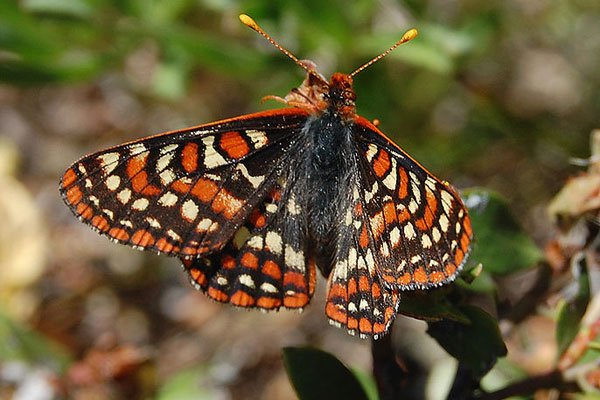A species of rare butterfly whose habitat was once scattered
throughout five counties in the Bay Area now only calls Santa Clara
County home, and may soon be classified as endangered.
A species of rare butterfly whose habitat was once scattered throughout five counties in the Bay Area now only calls Santa Clara County home, and may soon be classified as endangered.
The bay checkerspot butterfly’s numbers have declined so drastically in recent years that federal officials last week recommended upgrading its status from threatened to endangered under the Endangered Species Act, according to Al Donner of the U.S. Fish and Wildlife Service.
Based on the latest results of ongoing studies, the butterfly now lives predominantly in an area among the Coyote Ridge foothills, which extend from south San Jose to Morgan Hill on the east side of U.S. 101.
“There are some scattered populations in the hills on the west side (of the freeway), but those are much smaller,” Donner said.
The bay checkerspot butterfly was first listed as a threatened species in 1987. Its population declined from about 700,000 in 2004, to about 100,000 in 2005, and its numbers continue to fall, Donner said.
The butterfly used to be found in San Mateo, Alameda, Contra Costa and other counties in the Bay Area.
“We’ve known the numbers are declining, causing us to focus more heavily and redouble our efforts to help the species,” Donner said.
Those efforts include protecting the animal’s habitat, which exists among dwarf plantain groves in serpentine soils. The Santa Clara Valley Habitat Conservation Plan is a county-wide effort to preserve about 500,000 acres of habitat for 30 endangered and threatened species including the bay checkerspot, and align these efforts with development projects.
The plan includes restricting about 7,000 acres of bay checkerspot habitat from development and managing the property for the species’ benefit, Donner said.
If U.S. Fish and Wildlife is successful in its push to re-designate the checkerspot as endangered, it likely will not affect the plan as the species is already a focus.
“This confirms the urgency of the need” to protect the bay checkerspot’s habitat, Donner said.
Supervisor Don Gage said the bay checkerspot’s increasingly fragile existence could make it easier for Santa Clara County to meet its obligations under the plan, which is being administered by multiple agencies.
Some county parks already have serpentine soil – harsh soil derived from a specific type of bedrock – and are thus already protected, Gage said.
“From the county’s perspective, we’re already in a good position,” he said.
A once-ambitious plan to develop the valley below Coyote Ridge with 50,000 new homes has been “dead” since the housing market declined in 2007, according to plan program manager Ken Schreiber.
A couple of key factors have contributed to the bay checkerspot butterfly’s shrinking population in recent years. One is the increasing growth of non-native plant species that has crowded out the dwarf plantain, the butterfly’s only food source, Donner said.
Another is automobile traffic along U.S. 101, which is directly adjacent to the bay checkerspot’s home. Nitrogen emissions from passing cars act as a fertilizer for the non-native plants that encroach on the insect’s food supply.
“It’s part of the whole complex mosaic of the plant and animal life in California. Where you can develop recovery efforts that protect the species like this, you’re also protecting other native species,” Donner said.














